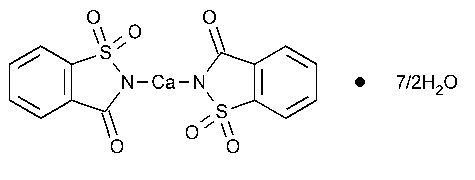Saccharin Calcium
1,2-Benzisothiazol-3(2H)-one,1,1-dioxide,calcium salt,hydrate (2:7).
1,2-Benzisothiazolin-3-one 1,1-dioxide calcium salt hydrate (2:7) [6381-91-5].
Anhydrous 404.44 [6485-34-3].
»Saccharin Calcium contains not less than 98.0percent and not more than 101.0percent of C14H8CaN2O6S2,calculated on the anhydrous basis.
Packaging and storage—
Preserve in well-closed containers.
Labeling—
Where the quantity of saccharin calcium is indicated in the labeling of any preparation containing Saccharin Calcium,this shall be expressed in terms of saccharin (C7H5NO3S).
Identification—
A:
Dissolve about 100mg in 5mLof sodium hydroxide solution (1in 20),evaporate to dryness,and gently fuse the residue over a small flame until it no longer evolves ammonia.Allow the residue to cool,dissolve in 20mLof water,neutralize with 3Nhydrochloric acid,and filter:the addition of a drop of ferric chloride TSto the filtrate produces a violet color.
B:
Mix 20mg with 40mg of resorcinol,add 10drops of sulfuric acid,and heat the mixture in a suitable liquid bath at 200 for 3minutes.Allow it to cool,and add 10mLof water and an excess of 1Nsodium hydroxide:a fluorescent green liquid results.
for 3minutes.Allow it to cool,and add 10mLof water and an excess of 1Nsodium hydroxide:a fluorescent green liquid results.
C:
Asolution (1in 10)meets the requirements of the tests for Calcium á191ñ.
D:
To 10mLof a solution (1in 10)add 1mLof hydrochloric acid:a crystalline precipitate of saccharin is formed.Wash the precipitate with cold water,and dry at 105 for 2hours:it melts between 226
for 2hours:it melts between 226 and 230
and 230 ,the procedure for Class Ibeing used (see Melting Range or Temperature á741ñ).
,the procedure for Class Ibeing used (see Melting Range or Temperature á741ñ).
Water,Method Iá921ñ:
not more than 15.0%.
Readily carbonizable substances á271ñ—
Dissolve 200mg in 5mLof sulfuric acid TS,and maintain at a temperature of 48 to 50
to 50 for 10minutes:the solution has no more color than Matching Fluid A.
for 10minutes:the solution has no more color than Matching Fluid A.
Selenium á291ñ:
0.003%.
Toluenesulfonamides—
Internal standard solution,Standard stock solution,andStandard preparations—
Prepare as directed for Internal standard solution,Standard stock solution,and Standard preparationsin the test for Toluenesulfonamidesunder Saccharin(see NFmonograph).
Test preparation—
Prepare as directed under Column Partition Chromatography(see Chromatography á621ñ),employing a chromatographic tube fitted with a porous glass disk in its base,a plastic stopcock on the delivery tube,and a reservoir on the top.Add a mixture consisting of 10g of Solid Supportand a solution of 2.0g,accurately weighed,of Saccharin Calcium in 8.0mLof sodium carbonate solution (1in 20),and proceed as directed for Test preparationin the test for Toluenesulfonamidesunder Saccharin(see NFmonograph),beginning with “Pack the contents.”
Chromatographic system andProcedure—
Proceed as directed for Chromatographic systemand Procedurein the test for Toluenesulfonamidesunder Saccharin(see NFmonograph).
Heavy metals,Method Iá231ñ—
Dissolve 4g in 46mLof water,add 4mLof dilute hydrochloric acid (1in 12),mix,and rub the inner wall of the vessel with a glass rod until crystallization begins.Allow the solution to stand for 1hour,then pass through a dry filter,discarding the first 10mLof the filtrate,and use 25mLof the subsequent filtrate for the Test Preparation:the limit is 0.001%.
Limit of benzoate and salicylate—
To 10mLof a solution (1in 20),previously acidified with 5drops of 6Nacetic acid,add 3drops of ferric chloride TS:no precipitate or violet color appears.
Organic volatile impurities,Method Iá467ñ:
meets the requirements.
Assay—
Accurately weigh about 500mg of Saccharin Calcium,and transfer completely to a separator with the aid of 10mLof water.Add 2mLof 3Nhydrochloric acid,and extract the precipitated saccharin first with 30mL,then with five 20-mLportions,of a mixture of chloroform and alcohol (9:1).Evaporate the combined extracts on a steam bath to dryness,with the aid of a current of air,then dissolve the residue in 40mLof alcohol,add 40mLof water,mix,add phenolphthalein TS,and titrate with 0.1Nsodium hydroxide VS.Perform a blank determination on a mixture of 40mLof alcohol and 40mLof water,and make any necessary correction.Each mLof 0.1Nsodium hydroxide is equivalent to 20.22mg of C14H8CaN2O6S2.
Auxiliary Information—
Staff Liaison:Justin Lane,B.S.,Scientific Associate
Expert Committee:(EMC)Excipients:Monograph Content
USP28–NF23Page 1744
Pharmacopeial Forum:Volume No.30(4)Page 1423
Phone Number:1-301-816-8323
